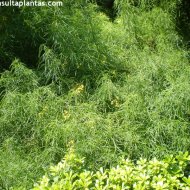Care of the shrub Senecio pseudolongifolius or Senecio lineatus |
|
The genus Senecio, family Asteraceae, includes about 1600 species of plants distributed on almost all continents, especially the Mediterranean climate regions. Some species are: Senecio pseudolongifolius, Senecio macroglossus, Senecio mandraliscae, Senecio kleinia, Senecio cruentus, Senecio barbertonicus, Senecio angulatus, Senecio stapeliiformis, Senecio serpens, Senecio elegans, Senecio bicolor, Senecio mikanioides, Senecio jacobsenii, Senecio scaposus, Senecio compactus, Senecio petasitis, Senecio rowleyanus. Scientific synonym: Senecio lineatus. This species is native to South Africa. They are rounded evergreen shrubs that reach 2 meters (6.56 feet) in height. The linear leaves up to 4 cm (1.57") long are glossy green. The showy yellow flowers appear in terminal corymbs. They bloom in spring. Senecio lineatus is used in borders, in rockeries, as isolated specimens, in bushy groups and to cover dry and sunny slopes. It's ideal for Mediterranean coastal gardens. Senecio pseudolongifolius prefers full sun exposure although it also grows in semi-shade. It resists occasional and light frosts. The soil can be a normal garden soil with 20% coarse sand; Senecio lineatus also grows in sandy, stony and poor soils as long as they have good drainage. Senecio lineatus is a fairly drought resistant shrub that needs moderate watering waiting for the substrate to dry out. Senecio pseudolongifolius does not need fertilizer. Prune lightly after flowering to maintain a compact habit. Senecio lineatus is a plant resistant to the usual pests and diseases. Senecio pseudolongifolius is propagated by cuttings and from seeds sown in spring. |
Images of the shrub Senecio pseudolongifolius or Senecio lineatus |
Find plants
Senecio pseudolongifolius or Senecio lineatus | Care and Growing
© 2025 FavThemes





